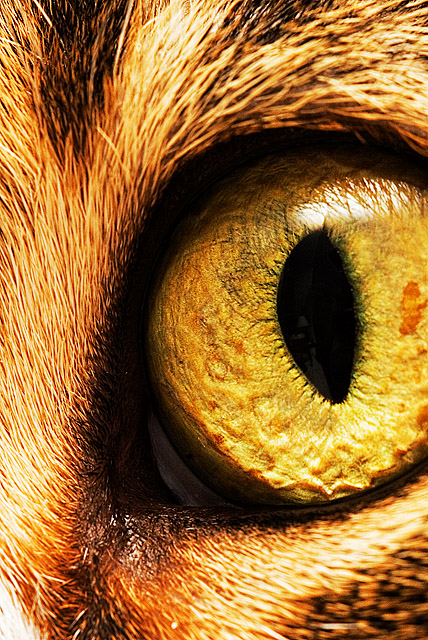Maueye : February 17, 2008

Image Data
File Name: 20D_15517
Model: Canon EOS 20D
Lens: Canon EF 100mm F/2.8 USM Macro
Date: 02.16.08 5:15pm
Focal Length: 100mm (160mm)
Shutter: 1/125 s
F-Stop: F9
ISO: 400
Program: Manual
Metering Mode: Evaluative
Flash: On
Flash Bias: +1.33 EV
Flash Details: External flash, E-TTL
Focus Mode: One shot AF
File Name: 20D_15517
Model: Canon EOS 20D
Lens: Canon EF 100mm F/2.8 USM Macro
Date: 02.16.08 5:15pm
Focal Length: 100mm (160mm)
Shutter: 1/125 s
F-Stop: F9
ISO: 400
Program: Manual
Metering Mode: Evaluative
Flash: On
Flash Bias: +1.33 EV
Flash Details: External flash, E-TTL
Focus Mode: One shot AF
Testing indicates that a cat's vision is superior at night in comparison to humans, and inferior in daylight. Cats have a tapetum lucidum, which is a reflective layer behind the retina that reflects light that passes through the retina back into the eye. While this enhances the ability to see in low light, it appears to reduce net visual acuity, thus detracting when light is abundant. In very bright light, the slit-like iris closes very narrowly over the eye, reducing the amount of light on the sensitive retina, and improving depth of field. The tapetum and other mechanisms give the cat a minimum light detection threshold up to seven times lower than that of humans. Variation in color of cats' eyes in flash photographs is largely due to the reflection of the flash by the tapetum.
Comments (0)
Colin
02.17.08 1:01am
Don't forget the third eyelid.
Ginny 02.17.08 10:09am
Moki says don't discriminate.....dogs have eyes, too!
Don't forget the third eyelid.
Ginny 02.17.08 10:09am
Moki says don't discriminate.....dogs have eyes, too!















 Subscribe
Subscribe


